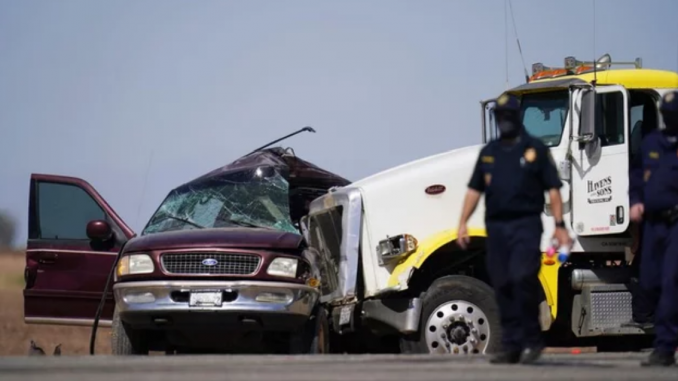
Sheriff Joe Frank Martinez has grown frustrated at his deputies having to fish bodies out of the Rio Grande.
Last week it was a Cuban male, found south of a weir dam. He was identified by the passport.
Sheriff Martinez figures there was probably another person with him, but that body hasn’t been recovered yet.
In January it was a woman, pregnant with twins. Her husband had also drowned, and his body was found on the Mexican side.
All told, Val Verde County, which sits along the Rio Grande just east of the Big Bend, has already recorded six migrant drownings this year. That surpasses all of 2020, and Sheriff Martinez says it’ll only get worse.
For him, the reason is clear: The new administration’s change in policy, which has offered would-be migrants hope that if they can reach the U.S., they’ll be allowed to stay.
“There is no consequence,” Sheriff Martinez told The Washington Times.
In 2019, photos of a 2-year-old girl, her arm wrapped around her father as they lay dead on the Mexican bank of the Rio Grande, splashed across newspapers’ front pages and television news casts, drawing attention to that year’s migrant surge.
The deaths this year have drawn far less attention, but they’re quickly rising.
In California, a horrific traffic collision killed 13 migrants, mostly from Guatemala. They were among a group of 25 who’d been piled into an SUV and who reportedly barreled through a gap in the border wall.
Last month’s deep freeze in Texas killed migrants across the state. Some were left to die by smugglers, while others’ bodies were carried along, unreported and undiscovered until the group ran into Border Patrol agents.
The scope of the deaths is not year clear.
Customs and Border Protection said it doesn’t have current border-wide numbers, although at the end of the Texas freeze, CBP said it had recorded 15 migrant deaths in Texas in February, and seven of them were due to the weather.
Those who work the border say as the numbers rise, they expect the injuries, deaths and exploitation to go up, too.
One particular worry is illegal immigrant children, who have been surging to the border in numbers that Homeland Security suggests could reach record proportions in just a month or two.
In 2019, during the last surge, U.S. Immigration and Customs Enforcement exposed an epidemic of “fake families,” or adults who bought or borrowed children to claim as their own, in order to take advantage of lax enforcement against illegal immigrant families.
ICE began DNA testing migrants flagged by CBP agents and officers as potentially fraudulent families.
More than 3,100 purported families were tested and 9% of them were found to be people not related to each other. Matt Albence, ICE’s director at the time, told Congress in March 2020 that the DNA testing and the ability to sniff out bogus family claims spurred “a dramatic decrease” in the number of people faking family relationships.
Mr. Albence, in his 2020 testimony, also said ICE spotted instances where children were being “recycled,” or used by one adult to portray members of an illegal immigrant family, granted admission to the U.S., then flown back to Central America to be used by another “family.” Mr. Albence said they were investigating “hundreds of recycled children.”
Current and former immigration officials say they expect those numbers to climb once again.
“It will happen again,” said Mark Morgan, who served stints as acting director of ICE and acting commissioner of CBP during the Trump administration.
There’s also likely fraud going on with children who show up at the border on their own, without anyone claiming to be parents, said Brandon Judd, president of the National Border Patrol Council.
Mr. Judd said an “overly large” percentage of migrant children right now are claiming to be 16 or 17 years of age.
“You have to start wondering, because how do you prove somebody is 20 years old who claims to be 16 or 17?” he said. “The burden of proof is on us to prove that they’re not what they claim to be.”
The Biden administration has pleaded with migrants not to make the journey, even as many of those migrants say the relaxed policies the new administration has put in place are exactly why they’re attempting the crossing.
“We are not saying, ‘Don’t come.’ We are saying, ‘Don’t come now,’ because we will be able to deliver a safe and orderly process to them as quickly as possible,” White House press secretary Jen Psaki said last week.
In Val Verde County, Sheriff Martinez says it’s time for the Biden administration to rethink its plans and come up with policies that will cut down the numbers.
He told The 830 Times, a website that covers Del Rio, that the Biden team tossed out the Trump methods but “didn’t have a policy in place, and now they’re struggling to catch up.”
In interviews with The Washington Times, Sheriff Martinez reiterated that point.
His rural county is far from the main smuggling routes in El Paso to the west and the Rio Grande Valley in the east. But the sparsely populated region still sees its share of dangerous crossings because of a weir dam that spans the Rio Grande just west of the international bridge connecting Del Rio to Acuña, in Mexico.
“It gets very slick with slime on it and people will attempt to cross through there and will fall in,” Sheriff Martinez said.
The pregnant woman who drowned in January, the sheriff said, was Haitian. The medical examiner determined the two unborn babies were at term, so they, too, count as deaths in the county’s tally.
Also in Mexico, authorities are investigating a shocking massacre of migrants in January in Camargo, which lies roughly south of El Paso.
Nineteen people were slain, and 12 state police officers have been accused of involvement.
Mexican authorities have not said what the motive was, but The Associated Press suggested they might have been in the pay of smuggling cartels.
A pickup truck carrying the migrants was likely part of a larger convoy headed toward the U.S.
*story by The Washington Times


